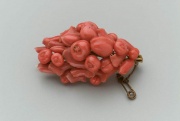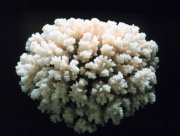Difference between revisions of "Coral"
(username removed) |
(username removed) |
||
| Line 2: | Line 2: | ||
== Description == | == Description == | ||
| − | 1) A [http://cameo.mfa.org/materials/fullrecord.asp?name=calcium | + | 1) A [http://cameo.mfa.org/materials/fullrecord.asp?name=calcium%20carbonate calcium carbonate] structure composed of skeletons from colonies of soft-bodied marine animals of the class Anthozoa (phylum Cnidaria). Coral deposits accumulate at an average rate of about 0.5 to 2.8 cm per year to form reefs or islands in warm seas (13-15 C). Coral falls into several classes called stony corals (star coral), black corals, thorny corals, horny corals (gorgonians), and blue corals. They can range in color from white, cream, red, blue, and black. Red, or precious, coral is considered the most valuable. It is obtained from the Mediterranean Sea and off the coast of Japan. Coral has been used since antiquity to make jewelry, ornaments, beads, and decorative objects. |
2) A pale orangy pink color. | 2) A pale orangy pink color. | ||
| Line 33: | Line 33: | ||
* ''The American Heritage Dictionary'' or ''Encarta'', via Microsoft Bookshelf 98, Microsoft Corp., 1998 | * ''The American Heritage Dictionary'' or ''Encarta'', via Microsoft Bookshelf 98, Microsoft Corp., 1998 | ||
| − | * ''Encyclopedia Britannica'', http://www.britannica.com Comment: Coral. Retrieved May 26, 2003, from | + | * ''Encyclopedia Britannica'', http://www.britannica.com Comment: Coral. Retrieved May 26, 2003, from Encyclopædia Britannica Premium Service. |
| − | * | + | * R. J. Gettens, G.L. Stout, ''Painting Materials, A Short Encyclopaedia'', Dover Publications, New York, 1966 |
| − | * | + | * G.S.Brady, ''Materials Handbook'', McGraw-Hill Book Co., New York, 1971 Comment: p. 235 |
* ''Dictionary of Building Preservation'', Ward Bucher, ed., John Wiley & Sons, Inc., New York City, 1996 | * ''Dictionary of Building Preservation'', Ward Bucher, ed., John Wiley & Sons, Inc., New York City, 1996 | ||
| − | * | + | * Tom Rowland, Noel Riley, ''A-Z Guide to Cleaning, Conserving and Repairing Antiques'', Constable and Co., Ltd., London, 1981 |
| − | * | + | * Oppi Untracht, ''Jewelry Concepts and Technology'', Doubleday & Co., Inc., New York City, 1985 |
| − | * | + | * Jack Odgen, ''Jewellery of the Ancient World'', Rizzoli International Publications Inc., New York City, 1982 |
* Art and Architecture Thesaurus Online, http://www.getty.edu/research/tools/vocabulary/aat/, J. Paul Getty Trust, Los Angeles, 2000 | * Art and Architecture Thesaurus Online, http://www.getty.edu/research/tools/vocabulary/aat/, J. Paul Getty Trust, Los Angeles, 2000 | ||
Revision as of 07:40, 24 July 2013
Description
1) A calcium carbonate structure composed of skeletons from colonies of soft-bodied marine animals of the class Anthozoa (phylum Cnidaria). Coral deposits accumulate at an average rate of about 0.5 to 2.8 cm per year to form reefs or islands in warm seas (13-15 C). Coral falls into several classes called stony corals (star coral), black corals, thorny corals, horny corals (gorgonians), and blue corals. They can range in color from white, cream, red, blue, and black. Red, or precious, coral is considered the most valuable. It is obtained from the Mediterranean Sea and off the coast of Japan. Coral has been used since antiquity to make jewelry, ornaments, beads, and decorative objects.
2) A pale orangy pink color.
Synonyms and Related Terms
calcium carbonate; coral (Esp., Port.); Koralle (Deut.); corail (Fr.); corallo (It.); sango matsu (Jap.); koraal (Ned.)
| Mohs Hardness | 3.5 |
|---|---|
| Density | 2.60-2.70 |
Additional Images
Authority
- The American Heritage Dictionary or Encarta, via Microsoft Bookshelf 98, Microsoft Corp., 1998
- Encyclopedia Britannica, http://www.britannica.com Comment: Coral. Retrieved May 26, 2003, from Encyclopædia Britannica Premium Service.
- R. J. Gettens, G.L. Stout, Painting Materials, A Short Encyclopaedia, Dover Publications, New York, 1966
- G.S.Brady, Materials Handbook, McGraw-Hill Book Co., New York, 1971 Comment: p. 235
- Dictionary of Building Preservation, Ward Bucher, ed., John Wiley & Sons, Inc., New York City, 1996
- Tom Rowland, Noel Riley, A-Z Guide to Cleaning, Conserving and Repairing Antiques, Constable and Co., Ltd., London, 1981
- Oppi Untracht, Jewelry Concepts and Technology, Doubleday & Co., Inc., New York City, 1985
- Jack Odgen, Jewellery of the Ancient World, Rizzoli International Publications Inc., New York City, 1982
- Art and Architecture Thesaurus Online, http://www.getty.edu/research/tools/vocabulary/aat/, J. Paul Getty Trust, Los Angeles, 2000




